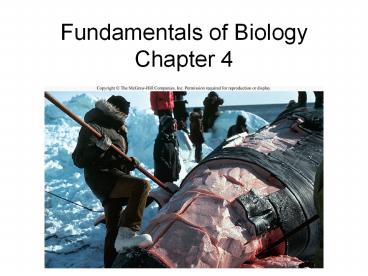Fundamentals of Biology Chapter 4 - PowerPoint PPT Presentation
Title:
Fundamentals of Biology Chapter 4
Description:
Fundamentals of Biology Chapter 4 Levels of Organization Atom Level Tissue Level Ecosystem Level Molecule Level Individual Level Organelle Level Organ System Level ... – PowerPoint PPT presentation
Number of Views:157
Avg rating:3.0/5.0
Title: Fundamentals of Biology Chapter 4
1
Fundamentals of BiologyChapter 4
2
Levels of Organization
- Atom Level
- Tissue Level
- Ecosystem Level
- Molecule Level
- Individual Level
- Organelle Level
- Organ System Level
- Cell Level
- Community Level
- Population Level
- Organ Level
- Atom Level
- Molecule Level
- Organelle Level
- Cell Level
- Tissue Level
- Organ Level
- Organ System Level
- Individual Level
- Population Level
- Community Level
- Ecosystem Level
3
The fundamental unit of all matter
Atom
Combinations of atoms that are bonded together
Molecule
A subcellular membrane- bound compartment
Organelle
4
Cell
The basic unit of life
Group of similar cells that perform a common
function
Tissue
Organ
Two or more different tissues that perform a
common function
5
Organ System
Group of related organs that have a common
function
Individual
A single organism
All individuals of the same species that occupy a
given area
Population
6
All the species in an ecosystem that can interact
Community
A community and its physical environment
Ecosystem
7
The Ingredients of Life
- Elements- substances composed of only one type of
atom. - 94 naturally occurring.
- Carbon, Nitrogen, Hydrogen, and Oxygen account
for 90 of the elements in living things.
8
The Building Blocks
9
Cells and Organelles
10
Eukaryotic vs. Prokaryotic Cells
- Feature Eukaryotic Prokaryotic
- Organisms Animals, plants Bacteria, Archaea
- Size 10-100 µm 1-10 µm
- Organelles Yes No
- DNA form Coiled, linear Circular
- DNA location Nucleus Cytoplasm
- Internal membranes Yes No
- Cytoskeleton Yes No
11
Robert Hooke (1635-1703)
12
Cell Theory
- CELL THEORY- proposed in 1839 by Schleiden and
Schwann. - All living things are composed of cells.
- The cell is the basic unit of life.
- New cells arise only from preexisting cells.
- Cells contain hereditary information which is
passed from cell to cell during cell division. - All cells are similar in chemical composition.
- All of the energy flow of life occurs within
cells.
13
Invention of the Microscope
- Invented circa 1595 AD by Zacharias Janssen
(1580-1638), a spectacle maker from Holland.
14
4 Types of Microscopes Used to Study Cells
- Dissecting microscope- 4-50X.
- Light is passed through or reflected on a
specimen. - Focus with a set of glass lenses.
- Compound light microscope- 1,000X.
- Light is passed through a specimen.
- Focus with a set of glass lenses.
- Transmission electron microscope- 50,000X.
- Electrons are passed through a specimen.
- Focus with a set of magnetic lenses.
- Scanning electron microscope- 10,000X.
- Electrons are scanned over the surface of a
specimen that has been coated with a metal. - No Focus, produces a three-dimensional image
collected from electrons that are emitted from
the metal.
15
Dissecting Microscope
16
(No Transcript)
17
Diffusion
- Diffusion- the spontaneous tendency of a
substance (solute or solvent) to move from a more
concentrated to a less concentrated area. - T or F. Diffusion results in the uniform
distribution of a substance.
18
(No Transcript)
19
(No Transcript)
20
(No Transcript)
21
Osmosis
- Osmosis- the diffusion of water through a
selectively permeable membrane from a region of
higher concentration to a region of lower
concentration.
22
When referring to two solutions that are
separated by a selectively permeable membrane
- Isotonic solutions have the same concentration of
solute as the cell. - Hypotonic solutions have lower solute
concentrations than the cell. - Hypertonic solutions have higher solute
concentration than the cell.
23
(No Transcript)
24
3 Domains and 6 Kingdoms
25
Classifying Living Things

